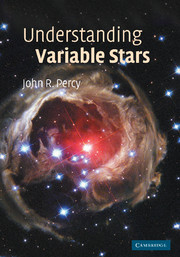Book contents
- Frontmatter
- Contents
- List of Boxes
- List of Figures
- List of Tables
- Preface
- 1 History and development
- 2 Stars
- 3 Variable stars
- 4 Rotating variable stars
- 5 Eclipsing variable stars
- 6 Pulsating variable stars
- 7 Eruptive variable stars
- 8 Pre-main-sequence variable stars
- 9 Miscellaneous variable stars
- 10 Epilogue
- Appendix: Acronyms
- References
- Resources
- Index
1 - History and development
Published online by Cambridge University Press: 28 October 2009
- Frontmatter
- Contents
- List of Boxes
- List of Figures
- List of Tables
- Preface
- 1 History and development
- 2 Stars
- 3 Variable stars
- 4 Rotating variable stars
- 5 Eclipsing variable stars
- 6 Pulsating variable stars
- 7 Eruptive variable stars
- 8 Pre-main-sequence variable stars
- 9 Miscellaneous variable stars
- 10 Epilogue
- Appendix: Acronyms
- References
- Resources
- Index
Summary
Sometime, far back in prehistory, people first began watching the sky. They must certainly have noted the daily and yearly motions of the sun, the waxing and waning of the moon, and perhaps even the wanderings of the planets. They might even have noted changes in the stars, not changes of position but changes of brightness. There are hundreds of these variable stars among the naked-eye stars, and the changes of some of them are so striking that they could not escape the notice of a careful eye.
Written records of skywatching begin in the Near East around 2000 BC, and in the Far East around 1000 BC. Unwritten records may also exist: paintings, rock and bone carvings, alignments of giant stones. The study of these has been called archaeoastronomy. The interpretation of any ancient records is a challenge to both the astronomer and the historian, and many interesting books and articles have been written on the topic.
The Babylonians laid the foundations of Western astronomy through their mathematics and through their systematic observations of the sun, moon, planets, and stars (albeit for astrological purposes). Babylonian astronomy was absorbed into Greek culture, where it eventually led to ‘models’ of the visible universe. In some schools of philosophy, these models were intended as mathematical conveniences, designed only to represent or predict solar, lunar, or planetary motions. In other schools, these models took on wider significance: they were intended to represent physical reality. Aristotle (384–322 BC), for instance,
- Type
- Chapter
- Information
- Understanding Variable Stars , pp. 1 - 13Publisher: Cambridge University PressPrint publication year: 2007



